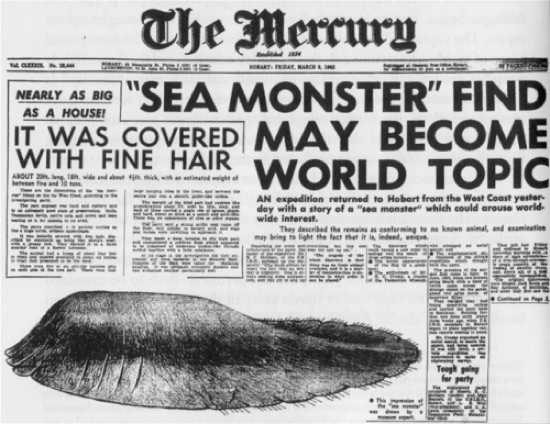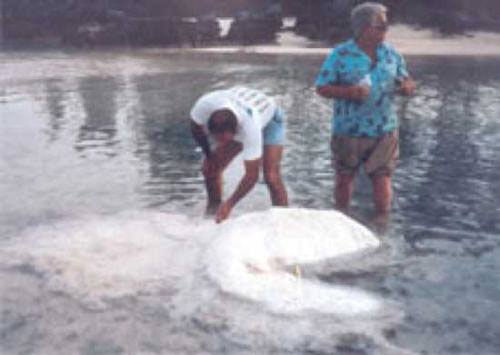10 most famous aquatic monsters of all time
Many years have passed, science and technology has improved a lot, but so far a series of huge, strange animals washed up on the coast below is still a mystery. Some are thought to be whales, but most of them are still unknown to any creature.
10. Tasmanian sea monster was discovered in August 1960

Tasmanian water monster became the subject of public opinion right after it was discovered
Also known as "Tasmania Blob" , this sea monster landed on the Tasmanian coast in 1960. When discovered, the mysterious creature died. It has an eye defect but its mouth is covered with white hard fur and is exceptionally big with a length of 6m. The media gets the scoop and release of the thrilling stories about Tasmanian sea monsters.
At that time, the scientific community could not identify the bone structure of the animal so they thought that this could be a new mammal. The mysterious veil covered Tasmania's aquatic life 21 years later, that is 1981, only to be answered.
With the support of advanced science, scientists analyze the bone structure of the sea monster and conclude, this is a whale.
9. Bermuda monster was discovered in May 1988

The famous Bermuda monster turned out to be a sick dolphin
In early 1988, a fisherman named Ted Tucker stumbled across a mysterious creature on the Bermuda coast. This creature is described as white with 5 limbs. Like many famous water monsters, Bermuda has no eyes, mouth or any specific characteristics to identify.
Therefore, Bermuda is a mystery until 7 years later. Thanks to the advancement of science and technology, Bermuda is officially identified as a sick dolphin.
8. Gambo Monster was discovered in June 1983

Gambo monster is still a mystery to biologists
The aquatic monster was discovered by young boy Owen Burnham , 15 years old on the Bungalow beach in Gambia. This event caused a stir when no one had ever seen a creature similar to Gambo. The name of the monster is named after the place where it was discovered.
So far, the mystery surrounding the Gambo monster has yet to be solved. The reason is, right after being discovered, the sea monster is transferred to a nearby village and cut off. The villagers even cut off the monster's head and sold it to a tourist. There were no photos other than the quick sketch of the little Owen about Gambo. So, until now, scientists are still not sure about the background of this sea monster.
7. Waterbending Augustine was discovered in November 1896

As one of the most famous and discovered sea monsters, Augustine marine life was discovered by a group of children
Augustine was a buzz when it was originally thought to be a new giant squid because of its dull pink skin, characteristic of this species. This hypothesis exists until 29 years later.
However, in 1925, when the giant squid was actually discovered and recognized as a new species, it was enlightened that Augustine was another species.
The reason for this confusion is because the sea monster Augustine not only has the same skin color as the squid but also has tentacles. In total, Augustine had seven long and slender tentacles that were proportionate to its giant body. However, some tentacles were broken and drifted, scattered on the coast. Meanwhile, the head of the sea monster looks like a sea lion.
Today, with scientific advances, it is confirmed that the aquatic creature Augustine is the corpse of a sick whale.
6. Montauk monsters were discovered in July 2008

Montauk corpse on New York beach
Montauk aquatic monster was discovered at a beach in New York state. This creature has a bird-like head but the lower jaw has teeth. Meanwhile, Montauk's body resembles a dog but does not have any hair at all.
Since its discovery, scientists have yet to solve the mystery of Montauk's origin. Some people claim that Montauk is a sick panda. This explains how it has been shed and lost its upper jaw. However, this hypothesis was opposed by many people because the panda leg was much shorter than the foot of Montauk.
5. Water monsters in Newfoundland were discovered in August 2001

Water monsters were discovered on Newfoundland beach
It also caused a stir when it was discovered, but the aquatic monster in Newfoundland was quickly determined by the scientific and technical advances. The monster was identified as a giant , fish-type sperm whale. Biggest elephant in the world.
In addition, scientists also explained how the large, heavy corpse of a giant sperm whale could drift ashore. They said that after the fish died for many years, the rotting process caused the hard bone inside the sperm body to decompose and permeate through the fat flowing out. The internal organs are also completely decomposed, leaving all fat-free corpses . This makes the fish bodies capable of floating on the surface of the sea and eventually washed up on a beach in Newfoundland by waves.
4. Water monsters in Chile were discovered in July 2003

So far, the aquatic history of Chile is still a mystery to biologists
Hydroponics in Chile is up to 12m long, weighs 13 tons. Initially, many biologists identified this as a giant octopus that has never been known before. This makes the whole world public buzz.
However, after that, the water monster was determined to be a whale. However, some other biologists are still not completely convinced with the above conclusion because at first, sea monsters were speculated as invertebrates .
3. Zuiyo-maru water monster discovered in April 1977

The body of the giant sea monster was thrown back to the sea
On a sea voyage, a group of Japanese fishermen discovered the body of a giant sea creature after it caught in their fishnet. The strange creature named Zuiyo-maru , after the name of the fishing boat. The sailors said that Zuiyo-maru is a long-ago ancient lizard known as 'Nessie'.
Despite the excitement, the fishermen have to throw back the sea monster's corpses, fearing that retaining Zuiyo-maru will cause the fish they catch on the rotten boat. Before throwing the animal, they wisely photographed it while retaining the animal's bones, flesh, skin and fat.
From the recorded images, the "monster" has four large fins on the side of the body, the neck is long, without dorsal fin like fish (may be lost) and the mouth is like a dinosaur. According to measurements, it is about 13m long, 2m long tail, weighs about 1.8 tons .
However, all of that cannot help biologists determine Zuiyo-maru's exact identity. Some assume that this is the body of a giant shark.
2. Trunko was discovered in October 1924

A man is using a tree to poke at the wreck of Trunko on the South African beach .
Trunko is the only aquatic monster alive when discovered. According to witnesses, a few days before being washed into a South African coast, Trunko is struggling to find a way out of two giant amphibians (killer whales). It must use its tail against the enemy for 3 hours.
In addition, the witnesses said that Trunko's appearance is very strange. It has snow-white fur covering the upper body (some people think this is a polar bear). In addition, the sea monster has a crustacean-like tail but loses its head, has no bone structure and does not even have blood .
Given the scientific and technical conditions of the time, it was difficult to determine the identity of Trunko. Currently, there are only 4 photos left of this monster and therefore, it is still mysterious to biologists.
1. Stronsay Hydroponic was discovered in September 1808

Stronsay aqua drawing picture
In 1808, after the storm landed on Stronsay Island in the melting Orkney Islands, a long giant creature wobbled against the shore.
More than 200 years since its discovery, the identity of this creature remains a mystery to scientists.
In terms of appearance, Stronsay has many similarities with the Loch Ness lake monster with very thin and long tails and necks, wide body with 3 short legs. The monster with mane consists of hard and pointed feathers covered from the neck to the lower back.
Stronsay is nearly 17 meters long, although it was discovered, a part of its tail was decomposed. At that length of time, many people thought that Stronsay was the corpse of a giant shark. Previously, the longest known shark was only 12m long. For a long time, natural history society experts in the city of Edinburgh, United Kingdom sought to determine Stronsay's background but failed.
- Scary aquatic monsters in New Zealand and the results of the study surprised many people
- Scary aquatic monsters on Earth
- Sea monsters really exist?
- 10 most dangerous species of freshwater aquatic monsters in the world
- The reason people always like to watch stories about sea monsters
- Exposing the truth behind the water-splattered photo of the beach
- Collection of formidable aquatic monsters
- 'Water monsters' eating shark meat may be human ancestors
- Find the mysterious monster that terrified Canadians
- Ghosts, aquatic monsters constantly appear on Google Earth
- 3 'water monsters' existed in life before dinosaurs appeared
- 10 aquatic monsters of the Amazon river
 The truth about the mysterious red-haired giant at Lovelock Cave
The truth about the mysterious red-haired giant at Lovelock Cave Inunaki Tunnel: The haunted road leading into Japan's 'village of death'
Inunaki Tunnel: The haunted road leading into Japan's 'village of death' The mystery of the phenomenon of human reflection before dying
The mystery of the phenomenon of human reflection before dying 6 mysterious phenomena, although science has been developed for a long time, still cannot be answered
6 mysterious phenomena, although science has been developed for a long time, still cannot be answered